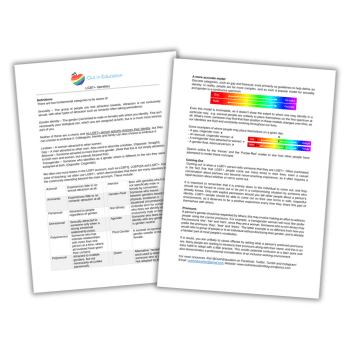Two-page PDF
KS1, KS2, KS3, KS4
Years 1-11
This resource sheet for teachers covers different gender identity and sexual identity terms.
It provides definitions for the following terms:
- Lesbian
- Gay
- Bisexual
- Transgender
- Cisgender
- Asexual
- Aromantic
- Pansexual
- Demisexual
- Polyamorous
- Polysexual
- Gender-fluid
- Non-binary
- Queer
This resource sheet also talks about thinking about sexuality and gender as a continuous spectrum. It also lays out some criticisms of this model.
Coming out
The resource explains what ‘coming out’ means and gives advice to education staff about telling other people about a student’s identity.
Pronouns
You’ll also find advice in this download about respecting students’ pronouns, and what to do if you’re in doubt about someone’s pronouns.
Gender identity vs sexual identity
Your sexual identity reflects the group of people you feel attraction towards. Attraction is not exclusively sexual. Sometimes other types of attraction, such as romantic, take precedence.
Your gender identity is about the gender with which you identify. This isn’t necessarily your biological sex, which you are assigned at birth, but is a much more intrinsic part of you.
Neither of these are a choice. No LGBT+ person actively chooses their identity, but they can choose to embrace it. Colleagues, friends and family can also choose to embrace it.
Out in Education is a not-for-profit organisation dedicated to raising awareness of the LGBT+ community in schools. It works with schools to design and deliver workshops, assemblies and lessons to combat homophobia and transphobia, educating school children about different sexual and gender identities. Browse resources for LGBT History Month and Pride Month.














